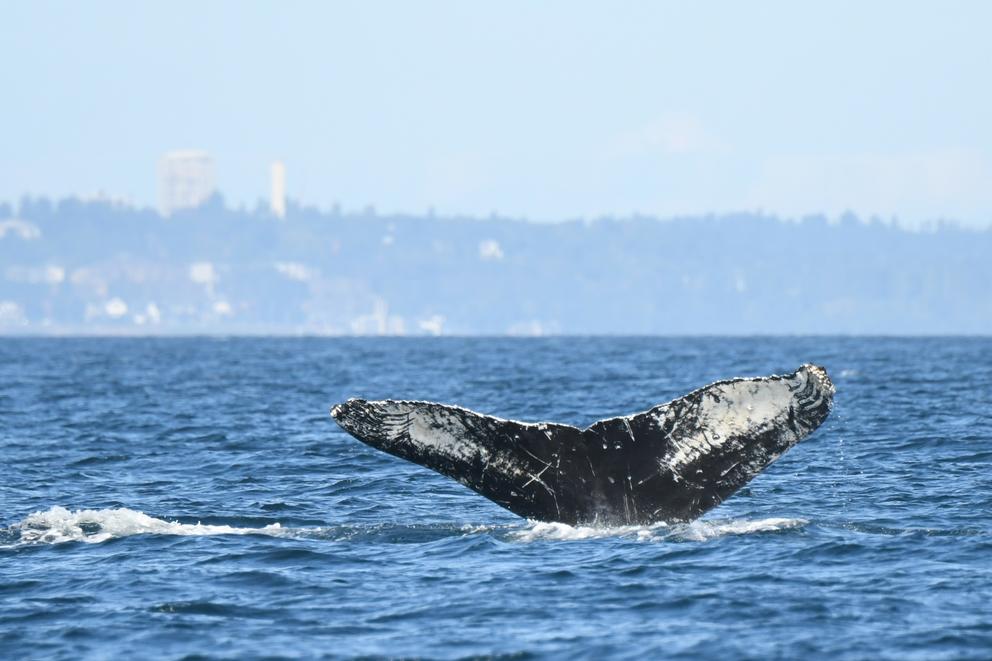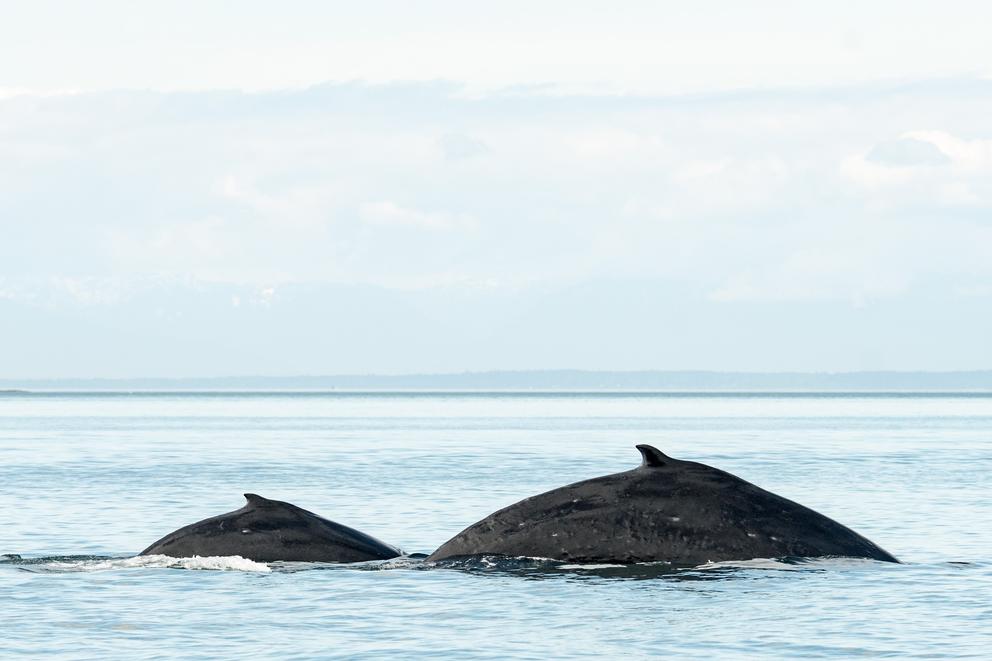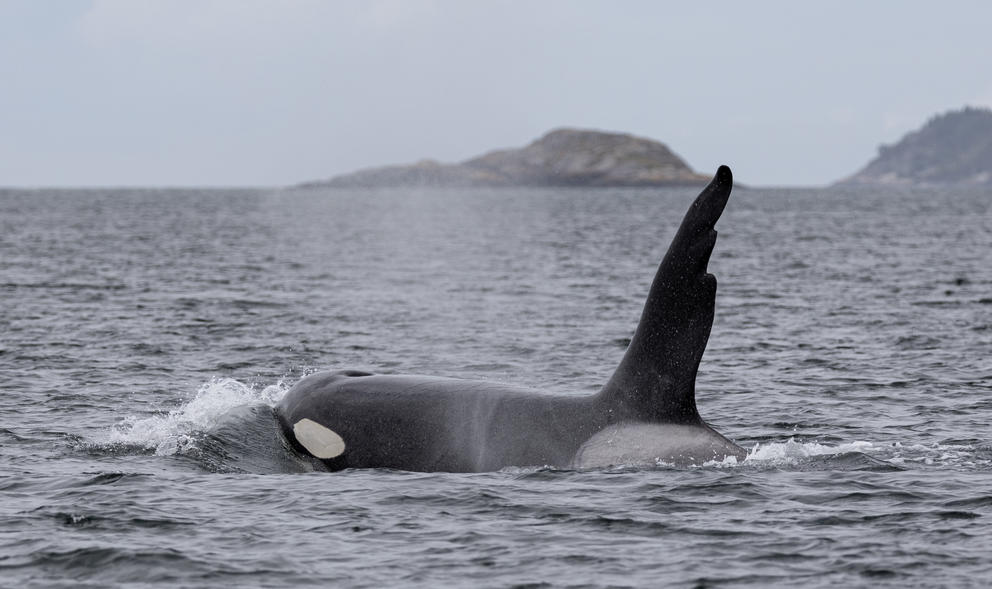“I need to call my mom,” she told her whale-watching group. When she got back to the office, a colleague saw her crying happy tears. Bethany had recognized Hydra, named for the marking on her tail resembling a snake, from a research trip to Hawaii. “To get the chance to see her again was just really special, mostly because I just have this connection with her and I'd been really hoping all summer long that I would get to see her,” Shimasaki said months later.
There is a lot of variation in how we refer to our whale neighbors — from nicknames like Hydra to coded strings of letters and numbers like “Orca whale J14.” These names and IDs often tell us a lot about the whales, and just as much about our relationships with them.
The ways individual whales get their names and research identification codes isn’t globally standardized, which can create confusion for whale lovers and researchers alike. Many researchers also balk at the idea of nicknaming whales, period — but that’s changing. Amid efforts to better identify whales, researchers and whale-watching specialists alike say that sharing and learning about names and IDs can dramatically impact our chances of protecting whales we see in the Salish Sea from climate change and ourselves.
The hidden beauty in alphanumeric codes
Whale IDs are constructed in a variety of ways, because there are lots of species and lots of different research groups in charge of identification. But they’ve all developed identification systems for a reason, said Jason Holmberg of animal identification project WildMe. “Without a name, or without a number, a population model can't happen,” he said, referring to studies of how certain species are doing.
The number and letter systems differ, but often tell researchers something about the order in which whales were seen, the family group they might be related to, or even their coloring. While some people see IDs as cold, researchers like Deborah Giles, science and research director at Wild Orca, don’t: IDs can tell you something about a whale’s place within its family, which is deeply relevant for family-oriented animals.
For the Southern Resident Orcas we see locally, the Center for Whale Research started by Ken Balcomb has been the go-to source of alphanumeric whale IDs for at least three decades, Giles said. It’s a simple but effective code, designed by researcher Mike Bigg: A letter is a whale’s family name, and its number represents the sequential order in which Bigg recorded it. He started his documentation of orcas off northern Vancouver Island, where he named the first pod of whales he studied A Pod, then B, C and so on. By the time he reached Puget Sound, he was on to J. About 59 animals have been recorded in J pod, 125 in L pod and 45 in K pod. Today, there are about 73 Southern Residents.
The Center for Whale Research historically waits to give an animal an IDs until they’ve seen it three times and have a good reference photo.
Mammal-eating Bigg’s killer whales have different ID nomenclature, in which letters and numbers alternate to suggest parentage and birth order. The second daughter of the second daughter of the seventh Bigg’s whale ever seen, for example, might be T007B2, where “T” stands for Transient. “Some of those matrilines are quite confusing because we have females that are five [generations] deep now,” Giles said.
There are many regional groups that give IDs to humpback whales — some animals have six or seven different ID codes. But locally, photo identification project Humpback Whales of the Salish Sea usually has the last word. To date, the project founded by naturalists Tasli Shaw and Mark Malleson has collected photographs of and catalogued more than 800 whales. Their IDs include sequential numbers in order of recording, but also prefixes to indicate which research group identified them, and mixtures of the letters X, Y and Z to indicate the coloration of their tails. A whale known as BCZ0029 would be a whale first identified by Fisheries and Oceans Canada, with a fluke that is almost entirely white, and the 29th humpback added to a catalog.
Cascadia Research Collective, cofounded by senior research biologist John Calambokidis, is the arbiter of gray whale IDs in the Salish Sea, where nearly 17,000 whales have been identified. It also tracks thousands of blue and humpback whales. CRC used to embed more information in its IDs, but with over 5,000 unique IDs in its database, “it becomes kind of overwhelming,” Calambokidis said. The system is mostly sequential now.
Some whales rarely get names or research IDs. A rare few minke whales, like “Nick Jagger,” have names. “But beyond that we often just say ‘There’s a minke whale!’" said Erin Gless, executive director of the Pacific Whale Watch Association. A volunteer effort is attempting to create a local minke whale catalog, but it’s slow-going, she said.
The drive to name whales
It’s hard to connect with beings we can’t name, which can be a hurdle to whale conservation efforts, some scientists and conservationists agree. For most people, alphanumeric codes don’t give them fuzzy feelings.
“If you just rattle off a bunch of numbers, it goes right over people’s heads. So especially in places where we see the same whales over and over again, we really like to try and give them nicknames,” naturalist Shimasaki said.
Connecting with an individual animal incentivizes people to care about whales generally, Gless said. “It makes them see that the animal is more than just a blob in the distance, and you don't want to see anything bad happen to a whale that you've come to know and love.”
When a Washington State Ferry ran into and accidentally killed a humpback whale in 2020, Gless was devastated: It was Chip, a whale she had named for the chip in its tail. “It was not only a whale I knew, but a whale that I had personally named because I was the first to see it as a young baby,” she said. “As a result, we were able to tell the story of what happened moving forward with far more emotion. … As simple and silly as it may seem, you just don't appreciate that these whales have distinct personalities and life stories without giving them nicknames.”
Of the whales you might have opportunities to identify in the Salish Sea, all of the Southern Residents have names. About 60% of humpback whales, a few gray whales, and almost no minke whales have nicknames — a reflection of how much we know about these whales, and how much people tend to care about them, Gless said. “By the time you get to minkes, sadly, nobody is paying attention.”
Different groups use different nicknames, but certain organizations’ names gain more traction. The Whale Museum, an organization dedicated to teaching people about the Southern Resident orcas and their ecosystems, has been assigning names to orcas for more than 40 years. When the Canadian government issued a license to capture whales in 1976, the Museum’s Mary Jo Farrar says the Museum and Greenpeace Canada held naming contests, thinking it would inspire people to protest whale capture. Today the Whale Museum holds naming contests: Members nominate names and the public votes.
It’s a little different for humpbacks. Usually, the first person to photograph or otherwise document a humpback gets to nickname it, Gless said, “but there are hundreds of unnamed humpback whales.” Shimasaki recently had the honor of nicknaming a whale, a juvenile with an octopus-like pattern on his fluke. She suggested the nickname Tako, the Japanese word for octopus.
For a name to be successful, it usually needs to evoke something about the whale’s behavior or defining features. Orcas like Scarlett, who has very unique and visible scars from a difficult birth, seem to fit their names, Giles said. In 2016, humpback researchers named one of Big Mama’s calves based on its behavior. The calf Pop Tart jumped hundreds of times a day — like the famous pastry coming out of a toaster. “Even though it was kind of silly, it’s one of the ones that’s definitely the most memorable,” Gless said.
The Whale Museum recommends picking names that have to do with other names in the whale’s family — K Pod’s Spock just had a baby named Prosper, for instance.
Naming a family member
For some communities, how we name and talk about whales carries deeper meaning.
Members of the Samish Indian Nation and other Coast Salish peoples have a kinship with orcas, says Samish Chairman Tom Wooten. Samish people, members of the Lummi nation and others call orcas Q’ellhólmechen, which roughly translates from Coast Salish to “Our people that live under the sea.”
“In our tradition, it all leads back to one particular woman in the tribe who basically gave up her existence as a human to live with her mate, this big male killer whale,” Wooten said. Married to a man who mistreated her, the woman found joy in singing to orcas — including one special whale that approached her when she sang. Her husband got jealous about her relationship with the killer whale, tied her up, and attempted to kill the whale. She broke free of her bonds when she heard the whale scream, Wooten said, and jumped into the water to save him.
She was able to save the whale and “converted into a female Q’ellhólmechen, and that’s how we’re related,” Wooten said. Meanwhile, the jealous husband became a pile of rocks.
The story is also a reminder of the fragility of human life, Wooten said. Both he and orcas are salmon people, he said, subject to the same dangers. “With global warming, sea level rise, acidification of seawater, those salmon aren’t coming back like they used to — and we’re impacted … but the whales are even more impacted,” he said. “I hope everybody wakes up and realizes that we need to do a little more than we are.”
For a few decades, at the request of the Whale Museum, the Samish Indian Nation has been hosting potlatch ceremonies to give Coast Salish nicknames to descendents of orca whale J-14, who had been nicknamed Samish, to reaffirm that bond. Such whales include J-45, named Se-Yi'-Chn (Coast Salish for “younger sibling”); J-37, named Hy’Shqa (“blessing”); and J-49, T’ilem I’nges (“singing grandchild”). The Lummi nation held a naming ceremony to give a new collective family name, Sk’aliCh’elh, to the members of J, K and L pods.
When Samish people name whales, they often think about the ways they want people and whales to feel. “We’ve been [choosing] names that try to instill hope in the whales,” Wooten said. A cultural committee and linguistics director are currently working on a name for a whale they hope to name this summer.
The Samish nation has been hosting these naming ceremonies, much like the ones that have been held for human children, for at least two decades. Families ask specific attendees to offer good messages for the person or whale being named, and call witnesses to take stock of the day’s events. The ceremonies signal that these creatures should be just as cared for as all other people around us, Wooten says. “As relatives, we stand up our kin and announce to the world that we’re aligned with these individuals, and that whatever happens with these guys is happening to us, and this is who we are collectively,” Wooten said.
The hazards of naming whales
Who are we to name whales? is a common refrain among whale researchers.
There’s no official gatekeeper of names, but certain groups run the risk of appearing that way.
Some names also leave something to be desired.
“I don’t like calling J27 ‘Blackberry,’ because what the hell is that?” Giles said.
Others reflect misinformation. The gray whale Lucy ended up being biologically male. Calambokidis doesn’t feel that whales need to be gendered, but CRC renamed him Lucifer — a name reminiscent of gray whales’ historical nickname, devil fish.
It’s not just nicknames that create problems. Whales are migratory animals, encountering lots of different scientists all around the world with different ID systems. Sometimes scientists study the same animal without realizing it — complicating our understanding of whales.
More philosophically, naming animals brings the risk of anthropomorphizing or attributing human characteristics to them.
“We can’t get too presumptuous about thinking we know what they’re feeling, what they’re thinking, what their motivation is, but we can still relate to them,” Calambokidis said.
Naming whales isn’t really for the whales, but to increase our ability to talk and think and care about them as a neighbor.
“It's just a lot easier to get people to look at these animals as unique individuals with personalities if you give them a name like we do humans,” Gless said. While that’s not scientific, she sees people are more receptive to take action for animals they recognize.
As climate change and human activity continue to make life harder for whales, even hard-line scientists are embracing the power that whale names can have for conservation purposes.
Calambokidis’s Cascadia Research Collective recently paired with Orca Network to run a naming contest for a small number of gray whales known as the Sounders. He has been sobered by how much personalizing an individual whale can impact politics and public attention. “I’ve come to appreciate that this isn’t an either/or situation … and I’ve come to peace with it.”
With an expansion of bans on getting too close to Southern Residents, many people in the whale-watching community have been naming the more plentiful mammal-eating Bigg’s whales. “We needed people to want to see Bigg’s killer whales, too,” Gless said.
For many, the fact that we still have whales to name at all is what’s most important. “We’re just happy that they’re still having babies,” Wooten said.





